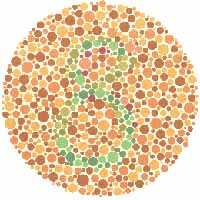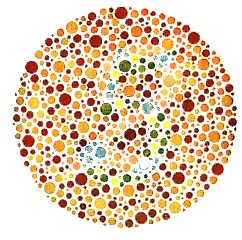Colorblindness
A friend of ours has periodic "game nights" at her house in Cambridge. Last Saturday Lisa and I went to one of these, and ended up playing a board game that relied on a scheme of colors connected to trivia cards. The game also had a die, with colored triangles printed on each face that corresponded to the game board. The die colors were not exactly the same shades as those printed on the cards or on the board; indeed, some of them were several shades off. The die's "yellow" side appeared to be a very solid orange. The "blue" and "purple" seemed almost indistinguishable to me, and in the dim light, I even had to look at a face for a couple of seconds in order to decide if it was green or red.
I have a "red/green" colorblindness, a very common type that is said to afflict about 1 in 12 males of European descent (women have it much less frequently). My brother has also tested positive for colorblindess, back when he was in the service - we just had an email conversation about the subject. I was first tested for it at about age 11, but I didn't believe the results until I found an online test involving the colored dots you see on this page. The web-pages from which I stole these images are here and here.
While there are some people whose color-deficiancy is so severe that they cannot distinguish between red and yellow traffic lights, and still others who see the world only in monochrome, "colorblindness" may not be a good term for this condition. When I mention it to people, most will start pointing at articles of clothing or upholstery, asking "what color is that? Do you see any difference?". I suspect that I can see 95% of the same colors as a normal person could; I usually have trouble discerning close shadings, especially when the lighting is poor.
There are some sites that attempt to show how the world looks to people with different kinds of colorblindness. It seems that the mildly colorblind see some colors as more "bleached out" than the normally-sighted, like a old magazine cover left in the sunlight, or how things look when you open your eyes at the beach, after laying in the sun with them closed.
[I can see what looks like a '5', or even a warped sort of '6' in the above circle. The real number is '8'.]
Interestingly, it seems that those with color-deficiency can see some things that the normally-sighted cannot; they can pick out patterns from complex backgrounds, and are said to be less confused by camoflauge. I'm not sure if this is supposed to be some inate effect, or whether the colorblind have simply become more adept at discerning shapes and patterns. I found a couple of online sources that talked about this:
"most color deficient persons compensate well for their defect and may even discover instances in which they can discern details and images that would escape normal-sighted persons. At one time the U.S. Army found that color blind persons can spot "camouflage" colors where those with normal color vision are fooled by it. "-- from here.and
"On the positive side, there is some evidence that colour-blind people are much better than average at certain jobs. They are very good at finding green things hidden against green backgrounds - for example grass or leaves. They tend to find things by shape and get less confused by camouflage. Because of this, colour-blind entomologists still catch lots of bugs and in wartime, armies prize their colour-blind snipers and spotters."--from here.





0 Comments:
Post a Comment
<< Home